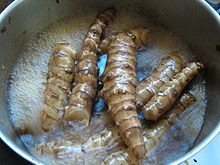Peanuts:
About:
The peanut (Arachis hypogaea), also known as "ground nut" and "goober", is a crop of global importance. It is widely grown in the tropics and subtropics being important to both smallholder and large commercial producers. It is classified as both a grain legume and , because of its high oil content, an oil crop.
Peanut pods develop under the ground which is very unusual among crop plants.
Peanuts are similar in taste and nutritional profile to tree nuts such as walnuts and almonds. The botanical definition of a "nut" is a fruit whose ovary wall becomes very hard at maturity. Using this criteria the peanut is not a nut but rather a legume. There are literally thousands of peanut varieties. The four most popular major groups are: Spanish, Runner, Virginia, and Valencia.
History:
The oldest known archaeological remains of pods have been dated at about 7600 years old. They were found in Peru. Cultivation of peanuts was well established in Mesoamerica well before the Spanish arrived. The peanut was spread worldwide by European traders, and cultivation is now widespread in tropical and subtropical regions. In the English-speaking world is most important in the U.S. . Although it was mainly a garden crop for much of the colonial period, it was mostly used as animal feed until the 1930's. The U.S. Dept. of Agriculture initiated a program to encourage agricultural production and human consumption of peanuts in the late 19th and early 20th centuries. George Washington Carver developed hundreds of recipes for peanuts during his tenure in the program.
Peanuts as Food:
Peanuts are processed into butter, oil, flour, and flakes. Peanut oil has a mild flavor and a relatively high smoke point. Peanut oil is monounsaturated and resistant to rancidity.
Peanut flour is lower in fat than peanut butter. It is high in protein and gluten free.
Boiled peanuts are a popular snack in the Southern U.S. as well as India, China, and West Africa. In the U. S. south boiled are often prepared in briny water.
Dry roast4ed peanuts can be roasted in the shell or shelled in a home oven spread one layer deep and baked at 350 degrees for 15 - 20 minutes for shelled, or 20 - 25 minutes in shell.
In the U.S. peanuts and peanut butter are the most popular nut choice and comprise 67% of all nut consumption.
Nutrition:
Peanuts are a very good source of copper, and a good source of manganese, vitamin B3, folate, biotin, vitamin E , phosphorus, vitamin B1 and protein.
Health Benefits:
Peanuts are rich in monounsaturated fats, which help reduce the risk of cardiovascular disease. Peanuts contain the same healthful fat found in olive oil and are also rich in antioxidants found in many fruits. Peanuts contain reservatrol, a flavonoid studied in red grapes and red wine which improves blood flow to the brain by as much as 30% reducing the risk of stroke./
The nutrients found in peanuts include folic acid, phytosterols, phytic acid, and reservatrol which may have anti-cancer effects. A 20 year study that collected data on over 80,000 women showed that women who eat at least 1 ounce of nuts, peanuts, or peanut butter each week have a 25% lower risk of developing gall stones. Research published in the Journal of Neurology, Neurosurgery, and Psychiatry indicates regular consumption of niacin rich foods like peanuts provides protection against Alzheimer's disease and age related cognitive decline. In another 28 month study 8865 adult men and women in Spain found participants who ate nuts at least 2x's per week were less likely to gain weight than participants who never or almost never eat nuts.
Selecting and Storing:
Shelled peanuts are available in prepackaged containers and bulk bins. In bins they should be covered and have a good turnover. Make sure there is no evidence of moisture or insect damage.
Whole peanuts in shell are usually available in bags or bins,. If possible shake to determine if they are heavy for their size and do not rattle, a sign they have dried out. These should be free from cracks, dark spots, and insect damage.
Shelled peanuts should be kept in a tightly sealed container in the refrigerator for up to 3 months, or 6 months in the freezer. Peanuts in the shell can be stored in a cool dry place, kept in the refrigerator their shelf life is about 9 months.
Allergies:
Peanuts are among the eight food types considered to be major food allergens in the U. S. requiring identification on food labels.
Peanuts have consistently determined to have high oxalate content. Oxalates are naturally occurring organic acids found in a wide variety of foods that need to be restricted to prevent over accumulation in the body.,
Uses:
- Spread some nut butter on your morning toast or bagel
- Make your peanut butter and jelly sandwich on whole wheat bread
- Fill a celery stick with nut butter for an afternoon snack
- Sprinkle a handful of nuts over your morning cereal, lunchtime salad, and dinner steamed vegetable
- Enjoy a handful of roasted nuts as a snack.
So..... Eat up! Enjoy! I'll show you how.
amzn_assoc_ad_type = "contextual"; amzn_assoc_tracking_id = "fruita0f-20"; amzn_assoc_marketplace = "amazon"; amzn_assoc_region = "US"; amzn_assoc_placement = "OZL7KATSDNEQZ7CN"; amzn_assoc_linkid = "OZL7KATSDNEQZ7CN"; amzn_assoc_emphasize_categories = ""; amzn_assoc_fallback_products = ""; amzn_assoc_width = "300"; amzn_assoc_height = "250";






























